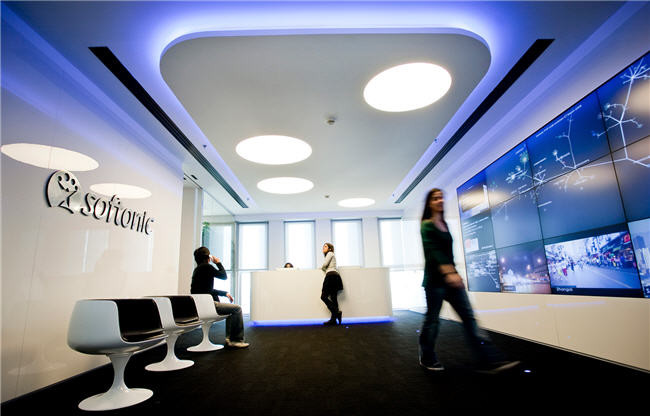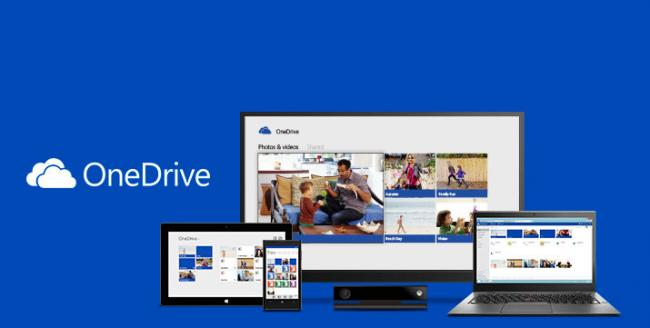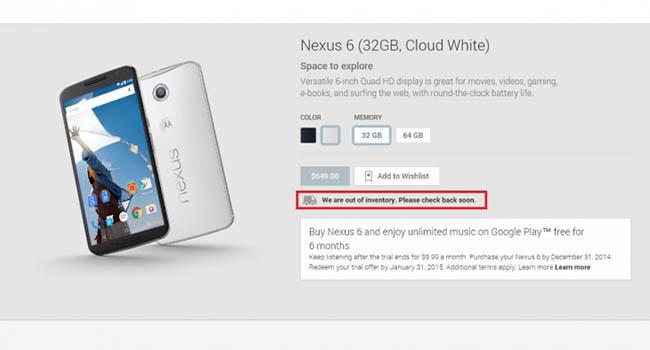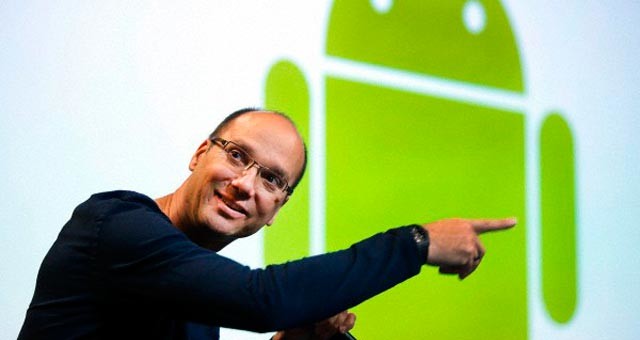
Technological Observatory October 27 to November 2
These are the stories we have lined up for you in this week's Technology Observatory:
● Digital music sales at iTunes Music fall 14%
● Orange extends its multi-device television to customers who only have a mobile connection
● Amazon unveils competition for ChromeCast: Fire TV Stick
● Quo vadis, Softonic?
● All Office 365 subscribers will now have unlimited storage on OneDrive
● First minute of Hangouts calls on Android devices free for 25 countries until the end of the year
● Honor, Huawei's new brand in Europe
● Nexus 6 sells out in the first half hour of pre-orders in the USA but may be delayed in Europe
● Google to reveal key details about Project Ara in January 2015
● Acquisition complete: Motorola is now owned by Lenovo
● Android co-founder Andy Rubin announces his departure from Google
Between 13% and 14% worldwide. That's how much sales at iTunes Music have fallen this year, as quoted by various sources for the Wall Steet Journal. What's happening to the recording industry? It looks like the recovery triggered by the sale of digital music was a temporary illusion rather than a permanent reality. Bearing in mind that in 2013 iTunes Music sales fell by 2.1%, a decline of nearly 14% this year is a crushing blow for the music industry, which had high hopes of climbing out of a crisis that has steadily deepened over the last 10 years. At least as far as traditional music and album sales go, because streaming and similar services are becoming more and more popular. What's more, it seems iTunes Music is not alone. There's evidence everywhere you look that the situation of the major recording companies is very far removed from what it used to be. While album sales in both CD and vinyl format have been in free fall for more than 10 years, digital music is now beginning to feel the pinch as well, as shown by the case of iTunes Music, one of the most widely used and highly rated digital music systems. And as several experts point out, things are not going to get any better. Last year revenues from subscriptions to streaming services and advertising mitigated the losses from more moderate sales, but the situation this year is far worse. However, irrespective of the fall in iTunes Music sales, Apple is pressing ahead with its plans to include Beats Music. Ever since its acquisition some time back, we've been wondering what they had lined up for Beats Music, and although there's no official confirmation it now looks like the service will soon be integrated with iTunes Music, suggesting a move toward new and better streaming services. So is the company giving up on the sale of digital music? This might well be a good time to introduce a new model, and like other companies Apple seems to be getting its act together in this respect.
If there is one thing that mobile-only customers of an operator that offers a pay TV service are likely to miss, it's not being able to access the service unless they take out a fixed broadband contract. The fact is that while operators that offer television provide users with the option of accessing it from different devices, until now it's mainly been an additional option for accessing channels through a decoder. But a year after launching the new Orange TV, the French operator has gone a step further by making the service available from now on to any mobile customer. These customers will now be able to access all the channels in the usual package for the same price as fixed broadband customers, and they'll also get an extra gigabyte of data for watching television. Multi-device TV seemed to have been born as an addition to the usual decoders offered by all the operators except for Vodafone, which uses Yomvi to offer television to its customers. Now, though, mobile customers of Orange will be able access the operator's TV service from their cell phone, tablet, PC or connected television set, without subscribing to fixed broadband. They will pay the same price as fixed broadband customers: €6 a month for the first six months and €12 a month thereafter. The added advantage for mobile-only customers is that they will get an extra gigabyte in their plan for watching television, which is roughly about six hours' viewing. These customers will be able to access all 33 channels offered by Orange TV as well as the à la carte TV service, which lets you record a program to watch within the next seven or 15 days, and the 600 or so movies from a range of genres available via the video club. This is an interesting initiative from Orange that other operators would do well to copy.
A device that connects to your TV to receive the content you see on your mobile devices: ChromeCast. The Google idea continues to encourage other companies to come up with similar solutions, as demonstrated this week when Amazon unveiled its own proposal: Fire TV Stick, for $39. Sold for just $19 in the first two days to Amazon Prime subscribers, on the website it boasts about offering more memory and storage space than Google's ChromeCast, space which it will need to temporarily store the content received and prevent annoying "buffering" stoppages (though personally I've never encountered that problem with ChromeCast). A dual core processor, 1GB memory, access to more than 200,000 television series and movies, millions of songs and hundreds of games, with 30 days' free access to Amazon Prime content, remote control, voice search, option of viewing your entire mobile content (from your Fire OS and Android phone or tablet), built-in access to Netflix, Prime Instant Video, Hulu Plus, Twitch and WatchESPN (in the United States) – it looks like these types of devices are going to dominate homes in 2015. They're practical, cheap and powerful (remember, Microsoft presented its own solution in this category just a few weeks ago). They've teamed up with scores of companies to offer their content directly via Fire TV Stick. Music, games, movies... the launch website even features a chart comparing this option with other alternatives, though there's no indication of when it will be available outside the United States, where it starts shipping on November 19.

For a few years the download business was something of a gold mine that enabled companies to quickly gain a firm foothold in the segment. Founded in 1997, Softonic was undoubtedly a benchmark in this country, carving out a leading position in a market now in decline. Such is the current state of the segment that Softonic recently confirmed that it would be downsizing and possibly laying off around 200 employees, or approximately half of its workforce. Falling revenues and the negative impact of the changes at Google have persuaded the management team and company director Tomás Diago to take this decision. The press release issued by Softonic confirms that the "collective dismissal will affect a significant number of people", and explains in fairly loose terms the reasons for the dismissals:
Changing market conditions have had a considerable impact on the download desktop business and they have a contributed to a steady decline in user traffic and revenues throughout the year. This decline has been compounded by the recent cancellation of important partner contracts.
According to the company, the most obvious reason for this fall in revenues is probably the exclusion of Softonic in the first Google search results. The world's most widely used search engine – with a particularly high market share in this country – changed its algorithms last summer. Matt Cutts, the engineer responsible among other things for controlling the spam in Google search results, announced in May of this year that the search engine was migrating to Panda 4.0 (last month Google Panda 4.1entered the scene with a few modifications). The search algorithm not only modified the engine's behavior but was combined with another tool that paid particular attention to searches with key words targeted at earning income, with a distinctly "spammy" focus. The tool in question is called Payday Loan Algorithm, which as explained at the time in Search Engine Land has nothing to do with Panda or Penguin, and is Google's "next generation of algorithms". The idea was to avoid Google results offering links to content regarded as bad, copied or "stolen" from sites with original texts. As reported in VivirDeLaRed that same May, the new algorithm was clearly detrimental to the interests of websites in the wordpress.com domain, where there are numerous blogs that capture and reproduce content from original sources, but also – naturally – to download sites like GratisProgramas and, of course, Softonic. However, these changes haven't affected all download sites in the same way, and in fact some services of this type have managed to gain rather than lose prominence. This is the case of PortalProgramas, which barely one week after the changes were introduced saw a 65% increase in traffic thanks to the efforts of the company's technical team, which Benjamín Segura described in the official blog of this service. One of the company's recent efforts has focused on addressing another of the great issues facing them in the future: the increasing prominence of app stores. Nowadays, these types of services are indispensable on cell phones and tablets, and that has made it difficult for Softonic to enter the sector. Even so, there still seemed to be hope for desktop computing. Not so much in OS X, where Apple, in its traditional style – "they're lentils..." – has been promoting its own app store and where features like Gatekeeper make it difficult to install third-party software from other locations. In light of this, Softonic turned to Windows and at the end of 2012 launched its client for that OS, which worked like any other app store and was therefore a direct competitor for Microsoft's official store, something that had been vaguely glimpsed following the arrival of Windows 8 and a somewhat confusing catalog in terms of differentiating between applications for the traditional desktop and applications for the Metro or Modern UI desktop. This process of transformation also involved an attempt to conquer cell phones and tablets, and for some time now Softonic has offered its client for both Android and iOS, in which once again we find an alternative app store to the official proposals from Google and Apple, respectively, and which logically competes with two giants with a much firmer foothold in the field of downloads and software installation in mobile devices. As we've already said, this app store focus in PCs, laptops, cell phones and tablets has to address two circumstances that could compromise its future. The first is the fact that the official stores are the natural reference point for both developers and users. Only a few specific stores manage to attract interest, depending on the scenario – Steam in games for PCs and laptops, the Humble Bundle sometimes for cell phones as well, for example – and even giants like Amazon find it difficult to provide outlets for their own store for Android devices, something which in fact they are currently trying to "silently" relaunch by adding that catalog to their generic Amazon mobile application. As already indicated, this ubiquitous presence of official stores striving to offer facilities to users and developers in these platforms is joined by a second problem: the decreasing use of PCs in favor of mobile devices, which in many cases are replacing desktop operating systems. Naturally, this means that applications – though not games – for Windows, Linux and OS X are not attracting the same interest as they once did. Not only that: an increasing number of companies are gradually launching subscription models – Office 365, Adobe Creative Cloud – and distribution models (like the Free-To-Play philosophy that lets you play the basic version free of charge but asks you to pay for any elements you add during the course of the video game), which further complicates the future for traditional downloads. These efforts have also been accompanied by another equally interesting phenomenon, very much in line with the times. Approximately 18 months ago Softonic tried out new ways of maintaining its prominence, one of which was to significantly reinforce the creation of its own content. This led to a stronger editorial section on the website, which was revamped to make news and articles (with their own sub-domains) a fundamental part of the new strategy. In the last few months, this strategy has gradually built up a new online medium featuring both technology news and more in-depth reports and comparisons of software. Even so, it doesn't look like the new focus has managed to minimize the impact of other problems, such as the aforementioned change of algorithms in the Google search engine. Obviously, this content strategy is also associated with a better SEO position and an attempt to avoid penalties imposed by search engines, but very real efforts have been invested in recent months. So although Softonic is facing an uncertain future, the company clearly has the capacity to react. Back in January Softonic announced that it had consolidated its status as the European company with the greatest following (it ranks 34th worldwide, according to comScore). This following is likely to be reduced in light of the new Google algorithm, but even so Softonic's inertia will make it easier – though not a piece of cake – to address the future. It has several options – we'll have to wait and see what they do about their SEO strategy – but there are two key possibilities. The first is a firm commitment to content, which would probably lose share in the Spanish and American markets. The company currently offers content and services in 10 languages, with around 70 employees dedicated to these tasks. The second option (in addition to the first option) is its reinvention or conversion into a catalog or guide for searching for and discovering new applications, probably a natural step for a company like Softonic and one that would enable it to make full use of its vast past experience. It will be interesting to see the course followed by a company which, curiously enough, has just announced the acquisition of a Silicon Valley startup "specialized in scraping mobile app stores", something which has naturally created a strange climate among the company's ranks. Softonic is now faced with a very complicated dilemma which will unfortunately affect a lot of people, and that's the real tragedy.

Microsoft has announced that everyone who has a subscription to Office 365 will now get unlimited storage to upload and manage all the documents they want in OneDrive. This new feature will be phased in gradually for all users, and according to the company will reach everyone in the coming months. As if a terabyte weren't enough, now all Office 365 subscribers will able to upload any content they want to their OneDrive account. It seems the move is in line with the plan to offer a single experience for all Microsoft services:
“While unlimited storage is another important milestone for OneDrive, the true value of cloud storage is only realized when it is tightly integrated with the tools people use to communicate, create and collaborate, either on a personal level or professionally.
That is why unlimited storage is just a small part of Microsoft's broader promise to deliver a single experience across work and life that helps people store, sync, share and collaborate on all the files that are important to them, all while meeting the security and compliance needs of even the most stringent organization."
The facility will be phased in for all subscribers, and may take some time to reach us. In any case, if you want to benefit now, you can put your name on the priority waiting list for Microsoft to assign you unlimited space as soon as possible.
Last month the messaging client Hangouts for Android devices introduced VoIP calls with Hangouts Dialer, a complement that you can install to call any number in the world using the economical rates of Google Voice. Now, several months after the service was rolled out for mobile devices, Google has decided to launch a special offer to encourage users to make calls with Hangouts: the first minute of calls to 25 countries will be free until the end of the year.
The following countries will benefit from this first free minute:
● Australia
● Belgium
● Brazil
● Canada: nearly all calls are free. Calls to certain numbers will cost you 1 cent/minute from the second minute. The rate of 1 cent varies according to the local currency. To see the cost of the call, go to the calling credit section of your Google account.
● China
● Dominican Republic
● France
● Germany
● India
● Indonesia
● Ireland
● Italy
● Japan
● Mexico
● Netherlands (Holland)
● Norway
● Peru
● Poland
● Russia
● South Korea
● Spain
● Sweden
● Switzerland
● United Kingdom
● United States: nearly all calls are free. Calls to certain numbers will cost you 1 cent/minute from the second minute. The rate of 1 cent varies according to the local currency. To see the cost of the call, go to the calling credit section of your Google account.

Huawei remains as committed as ever to Europe. Today it hosted an event in Berlin and revealed that its figures are every bit as good as those of its competitors. As well as reviewing its profile on the "Old Continent", it unveiled a surprise: Honor will be its new brand in Europe. The aim of this independent image is to create a Huawei experience adapted to this region of the world, and the move will undoubtedly reinforce and speed up the ways in which the company presents its devices. The Huawei Honor 6, unveiled a few weeks ago in China, is the device with which the company hopes to start carving out a niche in Europe. A high-end Android smartphone with a 5-inch FullHD display, 13MP camera, 3100mAh and Kirin 920 processor, the terminal will retail at €299. Finally with Honor, we now know for sure that smartphones from China will reach Spain and Europe, something which hasn't always been the case. The fact that a manufacturer like Huawei has created a unique brand for Europe is good news and will also help to keep the tabs on distribution costs. We hope to more about them as more devices reach this market. For the moment, we have the high-end Honor 6 and the new mid-range Honor 3C (€139). What do you think about the Huawei strategy?

It's happened again. This time it doesn't seem to matter that the price is above 600 dollars/euros. Google and forecasting stocks don't seem to get on very well: the Nexus 6 sold out in the first half hour of pre-orders in the United States, which is sure to have repercussions. In all four versions – black and white in its 32 and 64GB capacities – retailing at €649 and €699 respectively, the following message appears: "We are out of inventory. Please check back soon." So history repeats itself for the third year in a row, since the success of the Nexus 4 and the groundbreaking prices, at the time, of $299. Although this time the device doesn't have such an attractive price tag. Meanwhile, rumors from Holland suggest that running out of stock so early in the United States could lead to a delayed arrival in Europe. The pre-order stage for the Nexus 6 was expected to open at the end of the month (with terminals reaching stores some time in November), but the date now being bandied about is around November 18, which means a delay of between two to three weeks. If confirmed (which, knowing Google, might be verified simply with the passing of time), we'd be looking at a significant added delay, and we're still talking about pre-orders, not the actual distribution of the terminal. Clearly, this could be another reason for thinking twice about buying the Nexus 6, especially for those debating whether to go for that terminal or another one, like the Note 4. Could that have anything to do with it? What's your opinion?

Project Ara smartphones seem to be progressing well and Google has announced that next January 14 (Mountain View, New York, Buenos Aires and London) and 21 (Singapore, Bangalore, Tokyo, Taipei and Shanghai) it will be organizing two conference series to talk about "important changes and breakthroughs". In the official project blog, Google's Advanced Technology and Project (ATAP) group says it will also give a demonstration of the new Ara prototype at the conferences, and it will be then that we'll learn just how much progress has been made on one of the most unique developments of recent times in mobility. The fact that the conferences will take place in such diverse locations suggests that the company will announce new ways in which developers can collaborate with the project – some are already involved – and perhaps even how the project might be opened up to third-party ideas and applications. In any case, it is to be hoped that Google will use the conferences to share details about the release of the first Ara phones and modules, in theory due to arrive some time in 2015. The fact is that the project has made significant progress in a matter of a few months, and it will be interesting to see what Google and its engineers have lined up for those dates in January.
As everyone knows, the wheels of bureaucracy turn slowly: after an acquisition is announced, it usually takes several months to close the deal. Google confirmed that it had sold Motorola to Lenovo at the end of last January and now, on October 30 we can finally say that the operation is all done and dusted. Motorola and its entire current (and future) range of terminals will now be controlled by Lenovo, which has taken possession of the intellectual property portfolio, including "over 2,000 patent assets". According to its press release, this makes Lenovo the word's third largest smartphone manufacturer, though that remains to be confirmed as Xiaomi also claims to occupy that position. For its part, Motorola announced that although it will now depend on Lenovo, it will maintain its headquarters in Chicago's Merchandise Mart as well as its offices around the globe, including those in Silicon Valley. Lenovo has swallowed up the company's 3,500 employees – let's hope they don't do a "Nokia" like Microsoft did – and will retain the Motorola brand and the Moto and DROID franchises. The firm has also pledged to continue working on devices "with pure Android" and "offering the fastest upgrades", an aspect that worries many Motorola users. According to Motorola, things could not have worked out better: “In Lenovo we have a partner that shares our mission and that brings global scale, a diverse product portfolio and a track record of seizing strategic opportunities and making the most of them. Together we will go farther, faster. With an impressive portfolio of smartphones, wearables and PCs, our two companies will be uniquely positioned to push the boundaries of choice and value, and bring exciting new experiences to people everywhere.” With regard to Google, don't think for one moment that they've been left empty handed. As we've already reported, in addition to pocketing the ("approximately") $2.91 billion forked out by Lenovo, the company will also be keeping a significant number of patents as well as an arsenal of Motorola brains, which it will no doubt make the best of. Lenovo hopes to make Motorola a profitable business within four to six months. Let's hope so.

Internal changes at Google have never been so radical: the Mountain View company is about to lose one of its key executives. According to reports in The Wall Street Journal, Andy Rubin has decided to leave. The Android co-founder and one of the brains behind Google's growth into the company we know today is leaving his position as vice president of engineering, where he was responsible for the company's robotics departments, with developments like Project Wing. The reason for his resignation is his interest in creating an incubator for robotics startups and building technology through hardware, one of his greatest passions. In a press release, Google CEO Larry Page thanked Andy for his work and dedication since Google acquired Android in 2005: "I want to wish Andy all the best with what's next. With Android he created something truly remarkable, with a billion-plus happy users. Thank you." Following this move, it seems likely that Sundar Pichai will step up the post. After all, only a few days ago he received new and important responsibilities at Google, and he was the person who took over from Andy when he left the Android group. However, this hasn't yet been confirmed, and in the meantime the post will be filled by James Kuffner, professor and scientist at Carnegie Mellon University and a researcher for Google.
